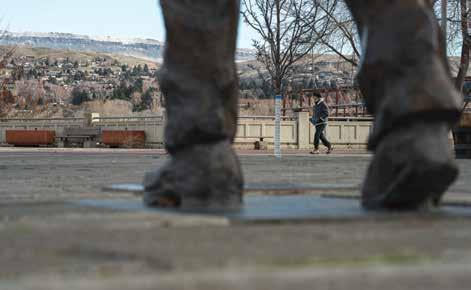
3 minute read
Local history
STORY BY MADELINE HAPPOLD PHOTOS BY LUKE HOLLISTER
The impact of Captain Alexander Griggs is commemorated with a statue in Wenatchee’s Riverfront Park. A statue of Griggs can also be found in Grand Forks, North Dakota, a community which he helped found in the 1800s.
Advertisement
Captain Alexander Griggs

Every day, Captain Alexander Griggs walks to work. He dons a smile, bronzed skin and a top hat. One arm is extended, hand giving a thumbs up, the other curled around a stack of books and a model steam boat. He stands at the foot of Fifth Street, facing toward Sternwheeler Plaza, on his way to another day of work at Wenatchee’s famous shipyards.
You may have passed him as you strolled on the Loop Trail or spent an evening sitting on the Hard Hat Winery patio. If not, you still have the chance — Griggs won’t make it to the office.

The “Captain Alexander Griggs Walks to Work” statue can be found at the foot of Fifth Street in Wenatchee.

Photo courtesy of Wenatchee Valley Museum & Cultural Center Captain Alexander Griggs
The “Captain Alexander Griggs Walking to Work” statue — created by sculptor Richard Beyer and artist Cheryl Wrangle — is part of the City of Wenatchee’s public art collection. The cast bronze sculpture was donated by the North Central Washington Museum in 1997, according to Wenatchee World archives. The push to immortalize Captain Griggs in Wenatchee history was the project of local historian Bill Layman, who helped raise funds for the statue by hosting a one-man theater performance of Griggs’ life.
Griggs’ story starts along the Ohio River in Marietta, Ohio, where he was born in 1838. He received his steamboat license at the age of 19, and began piloting steamboats on the Upper Mississippi and rivers in Minnesota. In 1870, after sailing along the Red River one cold winter night, Griggs and his crew found their boats had frozen in the river overnight. The crew built a cabin for shelter on a nearby shore, and one shelter soon turned into a small municipality.
The town was platted as Grand Forks, North Dakota, in 1875. Griggs helped establish the city’s first bank, the Grand Forks Roller Mill and the Griggs House hotel, according to the Grand Forks Historic Preservation Commission. Griggs’ influence on the town is also immortalized in a statue outside the county courthouse.
So, how did Griggs get from North Dakota to Washington?
His partner in the steamboat business, railroad magnate James J. Hill, convinced Griggs to go West for new business ventures. Griggs moved to Washington in 1892 to form the Columbia and Okanogan Steamboat Co., settling in current-day Brewster. He brought his profession with him and became the first man to operate a steamboat on the Columbia River. Along with moving mail and cargo,

Sculptor Richard Beyer’s detail work includes the captain’s belt buckle.
sternwheelers were the main transportation for travelers to get upriver. The boats could see up to 13,000 passengers a year, according to Wenatchee World archives.
In 1900, Griggs and his family moved to Wenatchee, where he lived until his death in 1903. He is buried in a private mausoleum at the Wenatchee City Cemetery.
In the decade following Griggs’ death, the steamboat business would be surpassed by the Great Northern Railway as the primary mode of transportation. Griggs’ statue in Sternwheeler Plaza is a memoriam to one of Wenatchee’s first trades.
While the steamships may be gone, Griggs’ legacy as one of the founding members of Wenatchee — and Grand Forks — is sealed in bronze. F
Sources
“New Sculpture for Riverfront” The Wenatchee World archives, Aug. 13, 1996 “Captain’s statue celebrates river days” The Wenatchee World archives, April 17, 1997 Grand Forks Historic Preservation Committee: wwrld.us/captgriggs The distinctive thumb-up on the Griggs statue created by Beyer and artist Cheryl Wrangle.







